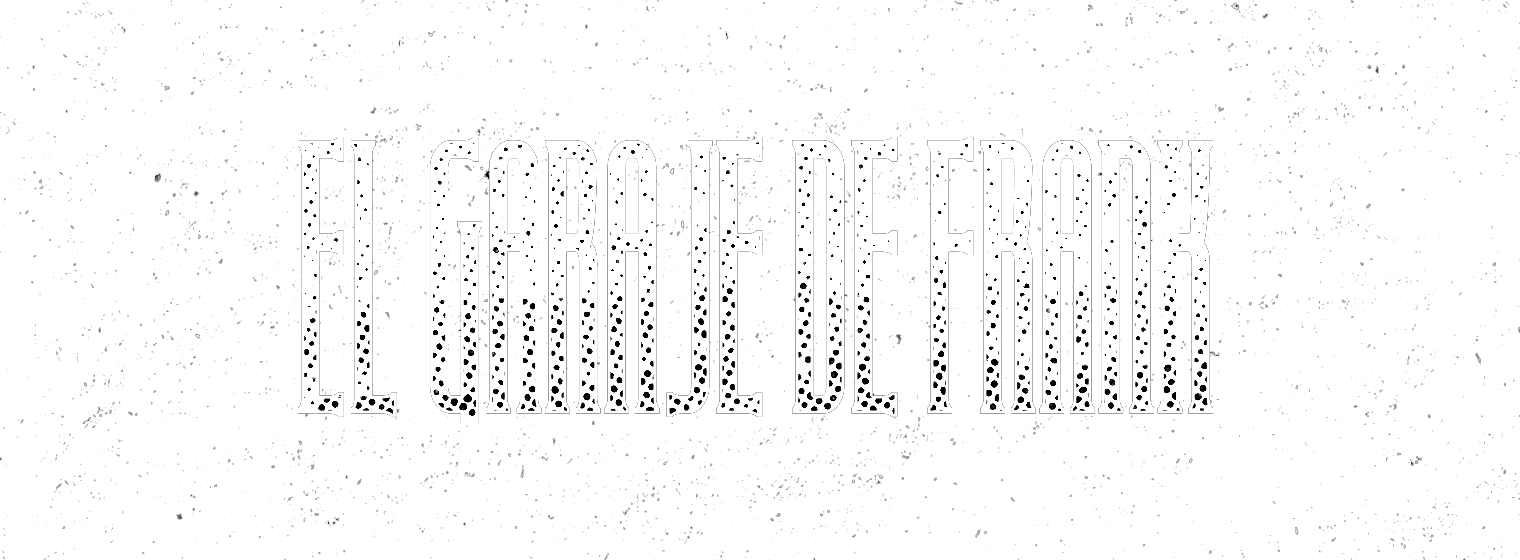Most of the public who went to Karl Hefner & Hugh Lagerfeld’s concert at DarkMad was surprised when they saw a girl as part of the duo. In the band’s promo pics that we had seen before, although masked, we could see two men. We thought that this was going to be an unresolved mystery but a few days after posting our chronicle of the event, the part of the duo that could not assist to the concert wrote us an email explaining what happened. In this interesting interview, you can know more about Arylia/Karl Hefner, his prolific career and discover why he wasn’t at the festival that took place in Madrid.
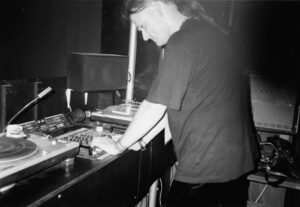
Arylia: Nights of the abyss fest 1998
—You started Djing quite at a young age, can you please tell us more about this?
—I started at age 13, this was very occasionally back then. I started to go out at this age and started to collect records even when I was younger. I went behind the turntables in the youth club in a town nearby.
I was a hard rock/metal fan and played not too extreme music, because to the club used to come people with different taste. So, I had to make sure they stayed in the club. But sometimes I couldn’t resist, and in between songs from The Red Hot Chilli Peppers, Aerosmith, Bollock Brothers… I sometimes, very rarely, played Napalm Death. This happened later, when I discovered death metal/grindcore. Later, my music taste was more influenced by different genres and then my sets had different varieties. At age 18, I played new wave-gothic-electro. And in my late twenties, I played alternative rock, disco, punk, metal, Goa trance… you name it. My record collection is big, and I listen to lots of different styles of music.
—You also played in some metal, punk and even grindcore bands. How do you remember those days? You played in The Difference when they were called Nasty Society, right?
—True. Before my teenage days I played drums on buckets. And I had a synthesizer with sampler. This was a toy. But music was something I wanted to do. At age thirteen, I had my first guitar. Some guys from school and I started a band. Influenced by punk and thrash metal we had our band named Nasty Society. I was not that good of a guitar player, and I left the band somewhere in 1989. I started my own bands with another guy, this was pure grindcore and punk. The grindcore project was named Fobofobia and the punk project was named Psychoterror (not to be confused with the other band who has the same name). We were not that good but had lots of fun. My influences lay in Napalm Death and Carcass.
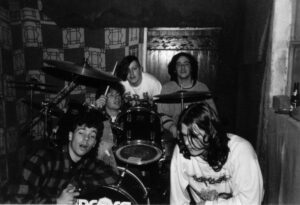
Nasty Society 1992
Later, I decided to go and see a rehearsal by my previous band Nasty Society. Back then, they had no vocalist, so I asked if I could sing on some tracks. They liked it, and I was back in that band. We did some gigs, and they were very good musicians. We were only 16 years old then.
We recorded some rehearsal tapes, some of the songs were later digitalized and can found on YouTube. Later I decided to leave the band because my interest was more in experimental/industrial music and the other members liked progressive metal. The drummer left at the same time, he was a punk, so it was not his cup of tea anymore to play that style of music. In the early days, we played hardcore punk/thrash. The band evolved more into doom/progressive metal. They changed their name into The Difference. I sometimes see those blokes; they are good guys. I stopped my grindcore project and played in other projects which were more punk based. I really like old-school punk like Charged GBH, Conflict, Subhumans, so the bands that I later played in were punky hardcore. One of the later bands I played in was Nineteen Stitches. A friend played drums, Frank, who was later in the death metal band Aborted (early days). I had many bands, I even played in a straight edge hardcore band. Sometimes I played bass, or drums. One funny moment I remember, Frank and I with other bandmembers had a gig. We only rehearsed once, and we had five songs. The night we had our gig with that band we played for more than one hour live on stage. We were very good at improvising and most of the songs we played then, were invented on stage. The bass player even left his bass guitar on the side and went stagediving.
—How did you get interested in electronic music? You said that you bought a first drum machine around 1995, right?
—Well, at very young age (15) I was interested in bands such as Pitch Shifter, Sonic Violence, Cable Regime, Scorn, G.G.F.H.… and I wanted to do something in this genre. Later I started to listen to Front 242 and bands in that style. I went to electro-wave parties since 1994. I loved the wave sound of The Cranes, X-mal Deutschland, wave and EBM stuff. I also was a huge Einstürzende Neubauten fan. Someone I knew sold his drum machine, a Yamaha RY10. He had a very good PA and he asked if I wanted to start a band. I was programming the drum machine and did guitars and he did bass. I loved the sound of the machine. I started a solo project named Der Verfall in 1995 (not to be confused with the German band) and started to make music in the style of G.G.F.H., Front 242 and Sheep on drugs. Back when I was about the age of ten, I listened to the radio to bands such as Talk Talk, Depeche Mode, SSS, Yazoo… the pop music on the radio was really good. My favourite song back then was and still is “Nineteen” from Paul Hardcastle.
So I had listened to electronic influenced music before.

Obverse Reality: after gig 1998
—In the following year, you created Obverse Reality, first called Subside Reflect. As you said it started being more synthpop and evolved into an electro project. Although the band started in 1996, only released a first EP in 2000. How were those first years?
—After Der Verfall, Subside Reflect was born, but I changed the name to Obverse Reality. This was a solo project at the beginning but later a good friend and almost neighbour joined in. Our first release was in 1998, a cassette, titled: In a dream. In 1999, we released a second tape containing a full live gig. Our music was a mixture between electro – industrial – and even synth pop, but we decided to separate the industrial from the electro-synth pop style. In 2000, Obverse Reality realised the first demo CD-r Emotions. The first days were lots of fun. Did some gigs in Belgium. On SoundCloud you can find some demos for free, but not the cassettes. Maybe the first cassettes will be online in the future.
The most memorable gig was in 2000, Eurorock, a 3-days festival with lots of great bands, we also played the Eurorock festival in 2002. And supported Attrition from the U.K. I did some gigs and loved to play on stage.
—When did you start with the fetish thematic? You already have songs like “Punish Me, lover” in some of your early releases.
—Well, I am a fetishist. And I love the fetish style. Also, fun to sing about it. Well to be honest, to be punished by my lover is not necessary. The fetish thematic started later in the nineties and stayed in Obverse Reality.
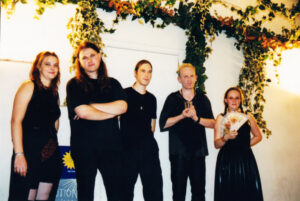
Obverse Reality and Atrittion.
—You were releasing this material by yourself. Was it difficult to get a name or gigs being totally underground?
—Yes, it was. I had to promote it myself. But I had some people who supported me from the beginning. I sometimes looked for gigs but mostly the organisers contacted me to play on their event. Also, fanzines did something for the support. Back then, there was internet, but none of us had it at home.
—Adorable You (2003) and Natures Gold (2004) sound better than your earlier material, maybe because I have only heard the remastered versions or maybe you had better gear. What do you think?
—The thing is that we had better material to record our stuff with. You can hear a big difference in the early stuff and the demos recorded in 2003 and 2004. In this period, I was assisted by Filip Ros from the Belgian indie rock band Arid, they were very big at that time. I knew Filip from the mid-nineties. Filip was the bass player in Arid. The guitarist was David, who lived in my town and the singer Jasper was my best friend at school. Filip produced the demos Adorable You and Natures Gold, which has more power and sounds very dirty. A big support came from the female singer ‘Klaartje’ who did, of course, the female part of singing. In the year 2002, I bought an electric guitar to pick up that part of playing and put it in my electronic music, so it gave more of a boost and live feel in the music. You can hear a big evolution between the early days and the later work. In 2006, Nathalie joined the band to take the vocal parts. The music back then was all hardware made, nowadays I combine hardware with software.
—You said that your concerts were close to stand-up comedy. Can you please tell us more about this?
—This is a fact. Obverse Reality was known for the hilarious acts. I remember a gig when I stopped the live gig because the PA man was calling on his cell phone. I took the telephone and stayed about 20 minutes during the show talking to the guy on the other side of the telephone having a hilarious conversation. Most of the times the people laughed. I sometimes do little jobs presenting a show, last one was about 5 years ago. But the Obverse Reality shows went out of proportion as it was sometimes more a comedian stand up than a music concert.
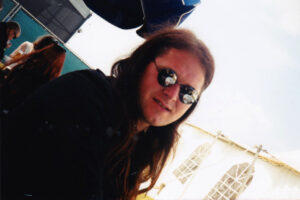
Arylia/Overse Reality at Eurorock 2000
—In The future ended…. today, the mood is less festive and the lyrics too. What happened for this change?
—Well, the theme in this release was the destruction of the world, rape… I used this theme before in Nasty Society. I wrote the song “World Destruction” in 1992. So that theme did reappear in the later Obverse Reality tracks.
But most of the time, these themes were present in the songs. I have always been influenced by not so positive things that happened in the world. The mood is indeed darker. So is the music.
—For a few years you did not produce anything with the project. Is it because Nathalie de Vlaminck left?
—Yes. Nathalie has a great voice, and I told her: if you leave, I will stop the project. This happened somewhere in 2007, I guess. I worked with 2 other girls, but it didn’t worked out. I started writing music for Obverse Reality when she told me that she wanted to get back in the band. So, we recorded new tracks with Sam. Dream Dimension came out in 2009. In 2012, we released The future ended… today.
—In 2021 you released new tracks, some of them with a more aggressive mood. What can we expect of Obverse Reality in the future?
—The new tracks are more aggressive and powerfully produced. Three songs are online: “Refurbitch”, “See Through and “Mirrorized”. The theme is social media. Also, we criticize some aspects of society. I will work on new material and will release a new EP very soon. The main thing is that we bring danceable EBM electro with the soft voice of Nathalie. Expect experimental influences too.
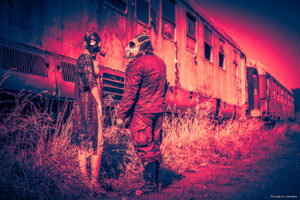
Synthetic Dream
—In 1999 you started your more prolific project, Synthetic Dream. Why did you start this one? Is it because you discovered goa trance?
—I discovered Goa trance in 1994 when I bought Trance in your mind. I was crazy about the song “Turn up the music” by Dr. Baker in the Leæther Bunny Mix, of course, by Claus Larsen from Leæther Strip. Leæther Strip was a huge influence for Obverse Reality by the way. The cd Trance in your mind was a very good trance album. The first track “Argon” by Oga Syndicate was a super track. Listening in the mid-nineties to EBM/electro, the thin line between Goa and EBM existed. In the late nineties, I bought Goa trance cd’s and records, it became one of my favourite music styles. Classic bands like Akanoid, Man with No Name, Chi-ad, Ethnica, Mind Warped… are still of my favourites. I discovered more and more, and that music was very interesting. The reason why I started Synthetic Dream is because I was making acid and techno with trance influences. I couldn’t make this under the name Obverse Reality, it was totally different. I released two cassettes in 1999. They are so rare, even I don’t have them. The project is still active.
—You made music for the German Fetish company Marquis. How was this collaboration born?
—Funny fact: I was a desktop publisher and one day I left early from work. The location of the company was in a big Belgian city. On that sunny day in 1999, I went shopping in the city, and I went to a big magazine/bookstore. Being a fetishist, I was searching for good magazines with beautiful woman in it. Then I saw the glossy high quality ‘Marquis’ magazine, so I bought it. When I was at home, I was looking through the pages and there was one picture I really liked, and I wanted that photo to be on my next album cover. I wrote a letter to Mr. Czernich with the question if I could use that particular photo. I added a demo cd-r in the envelope. I thought to myself… he will never write back. But… one month later I received an envelope with the letter from Mr. Czernich. The answer was that I could use the photo with his permission. He asked me to make music for his films, he liked my music a lot. So, I did. I’ve been two times to the Marquis studio in Solingen. Kind people. I made tracks at home, sent the tracks to his studio and his team placed the music in the right place in the films.
—The music of this project was sometimes ambient and sometimes closer to Goa trance. I guess the most ambient works are the soundtracks for Marquis, right? Is Goa trance the best term to describe your more Party material?
—The music for the fetish films is indeed ambient. Sometimes he used my Goa tracks as well. While making music I held the pictures of fetishism in my mind. So, the tracks were written. With this project, the music variates from ambient to Goa trance. It’s in the same style but like you said, the Goa trance tracks are more dancefloor stuff. For example, the best album that I made is Egosystem (2016). This album is downloadable for free on Soundcloud and bandcamp. This release starts with dark industrial ambient and then goes to Goa trance. Therefore, I released an album on Eric Van Wontergem’s label Berlin Beat records, named Future Machine. I released many cd’s with this project.
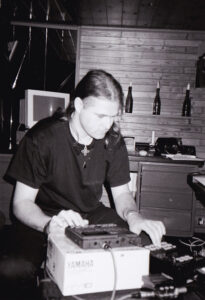
Neocortex1997
—You started an industrial project called Neocortex in 1996 and released two cassettes. Can you please tell us more about this? You said that your influences were Imminent Starvation, Sonar, Hypnoskull, and curiously, I am listening a lot to these bands lately. Were you following Ant-Zen and Hymen records? What did you like of these bands?
—Oooohhhh man, mid-nineties I bought lots of records of the Hymen records, you know, the records with the stamps on the cover. Tunnel, Sonar, Sona Eact®, Hypnoskull, Imminent Starvation, were some of my favourites, they came out on various record labels. I went to a few industrial gigs in the nineties and saw Dive, Sonar, Hypnoskull, Stigma, Esplendor Geométrico… live. The rhythmic noise and powerful beats really got me. So, I grabbed my drum-machine, and sent it to a Boss HM2 pedal, this pedal I still have because it’s a classic. I bought it in 1992 for my death metal/grindcore project. The sound that came out of the speaker was just blasting. The BOSS HM2 pedal was used at the end of the eighties, beginning of the nineties in bands like Carnage, Dismember, Entombed… classic Swedish death metal, and I loved the sound. Adding this pedal to a drum-machine, well… you get the sound in the style of Sonar, Imminent Starvation… Neocortex was a solo project, but live I was aided by one of the first keyboard player from Obverse Reality: Steven. He added dark atmospheric noises.
There is also a live tape that I have digitalized from video cassette. And yes, two cassettes were released, very rare, saw one on the internet long ago and they asked €50 for it, few years later it was worth €25. I don’t know why the price dropped. Fact is that I released one of the tapes in a steel case they used in surgery. I have one left.
Ant-Zen contacted me for a release on their label, but later they did decide not to release an album. Neocortex did one gig in the Netherlands. I stopped the project in 1999. There is also a band from nearby where I live named Neocortex and it’s also an industrial band, but I was first.
—In a completely different direction, you also started an ambient project Trübsinn. Did you record anything with this AKA?
—This was back in 1996. We released a 5-track ambient/industrial release. But we did not promote it that much. That project was with a friend named Mark. An industrial ambient label showed some interest, but never came to an official release. There is a book, which was released at the end of the nineties with all the Belgian wave/industrial/gothic/electro bands in. My projects Trübsinn, Obverse Reality and Neocortex are in it. The book is called De dag dat het zonlicht niet meer scheen (The day the sunlight went out).

Synthetic Dream 2015
—You said that you make music for yourself. Have you ever been tempted of doing more commercial music?
—Naaaaaahhhh, the music I make is something I like. You have people making music for others, commercial, to sell as many as possible. You have also the people who make music out of passion, which is what I stand for. I sometimes put on my own music on and enjoy it very much. It grows in the process and like what you have created. I’m no commercial man. Never followed trends, I have my own style of clothing and so on.
—Then in 2021 you met Dries (the other guy from Karl Hefner and Hugh Lagerfeld), whom you knew from school and asked him to remaster some of your works. How did you decide to work together later?
—I know Dries from high-school. We were 16 years old. After he left school, I didn’t see him from many years. Until 2006 with Myspace online, we met again. I needed to master my album: The future ended… today in 2012 so I asked if he wanted to do the job. While at his home, we decided to make music together.
—Why did you decide to use those names as monikers?
—Well, I came up with that name. We were on same levels of humour, so it worked out fine. I started to make videos for that project, because I had many experience in filming for my other bands. We agreed to stay anonymous, hiding our faces, and it worked. During a gig on the DAFT festival with Dive and Volkova, we were performing and the audience tried to figure out who we were.
After the gig I was in the hall with my mask off and some recognized me from Obverse Reality. They said: we were curious who was behind this project. So, the mystery remained for some years.
—What were your influences in Synthax Error? And what does the name of this EP mean?
—The name Synthax Error I came up with, because I programmed my basic computer when I was 12. If you entered a wrong code, the computer displayed ‘syntax error’. Being a synthesizer-based band, I changed it into ‘synthax error’. On the cover there is a picture that I took from a statue a friend made. The whole concept fits. Dark disco – trance and new wave were mixed. Minimal vocal lines by me with guitars. Having mostly common humour the tracks have some comedic touch in it. A main influence was Der Raumpatrouille, a German science fiction show from the sixties that I discovered in 2015. Also, I am a big science fiction fan, you can find that in the music I make.
This first release was on DAFT records by Dirk Ivens. We had a good friend who promoted us and realised our first album, which is Willy.
 —And Orion Express was your second EP. What differences do you see regarding your first album?
—And Orion Express was your second EP. What differences do you see regarding your first album?
—In fact, we didn’t had plans to release this EP. After our first album we just made new tracks. It’s a difficult album, with lots of influences. The album cover also contains a picture of a statue based on the first album cover. Willy wanted to release the EP. So, we did. This was on Berlin Beats Records. My favourite track is the last one, “Heather”. This song is about my crush on Heather Locklear (in the nineties). The second release shows a different angle in the music. We tried new things and went sometimes more experimental.
—Spanish label Logical Records released a digital EP with two of your songs and remixes. How was this project born?
—Javier contacted us to release “Shadow of the day”, a song which was born during jamming. Dries was on the synthesizer and I was on my guitar playing something in the style of sixties rock. The jamming went very well, and the song had its form after a few sessions. Javier liked the slow dark disco electro style. It’s a song with this in mind: A cowboy-like man is standing at a house in the desert, he knows an alien invasion is about to happen. He is preparing for the battle.
We needed another track to have an EP, so I wrote “T-800” which is of course a song about The Terminator. Being one of my favourite films, I had to do something with that theme. The song is dark and slow, like the terminator itself. Seeing that film when I was nine years old, it was great. I have seen this movie about, I think 15 times. So, we had two tracks, and people who Javier knew remixed our songs. It’s till available on Logical Records. Fun fact: one of the T-800 remixes is called “Connor” remix.
—In Disclike you made four covers, from bands as different as The Dark and The KLF, why did you choose these songs? I am especially curious about the cover of Bad Taste, the opening track of the Peter Jackson’s movie. I was a big fan of the movie when I was a kid.
—I know “The Masque” since 1996. It was covered by Forthcoming Fire and it was released on a We came to dance compilation. Later, I heard the original by The Dark at a punk’s home. It was on the Punk and disorderly compilation. I loved that song. I asked Dries if a cover was possible and he agreed. I wanted to do something different, slow and very melodic. This is a great cover. The KLF is the one song I used the midi files, so I re-arranged it with different sounds, being a huge fan of this song, I had to cover it. The covers are not obvious, I specially chose that. About The Bad Taste cover, well, I saw that movie when I was fifteen years old and loved it. I watched it many times. When the credits came on, the song from The Remnants “Bad Taste” began to play. It was constantly in my head. I even bought the picture disc from the movie. We were planning to cover it somewhere in 2007 with obverse reality, but it was postponed.
So later, I decided to do the cover with Karl Hefner & Hugh Lagerfeld. In fact, it sounds just like Obverse Reality: one of the reasons is that all the members were involved. Nathalie is on vocals and Sam on guitar. I totally rebuild the track. It sounds fresh and clean. But I like the original better, because the original singer sings like he’s hurt and full of emotion. I discovered “In the house”, while watching a horror movie called Slaughterhouse, a poor Texas Chainsaw Massacre look a-like. The scene where the teenagers are having fun was supported by this track. A song very little known. I found the track very catchy and wanted to pump it up. So, I did. I even went filming the video in an abandoned hospital with one of my favourite girls, who played a lot in my videos before, and made the clip look really old and low budget, like in the film Slaughterhouse. The original song is by Vantage Point, not to be confused with the hardcore band.
Obverse Reality: one of the reasons is that all the members were involved. Nathalie is on vocals and Sam on guitar. I totally rebuild the track. It sounds fresh and clean. But I like the original better, because the original singer sings like he’s hurt and full of emotion. I discovered “In the house”, while watching a horror movie called Slaughterhouse, a poor Texas Chainsaw Massacre look a-like. The scene where the teenagers are having fun was supported by this track. A song very little known. I found the track very catchy and wanted to pump it up. So, I did. I even went filming the video in an abandoned hospital with one of my favourite girls, who played a lot in my videos before, and made the clip look really old and low budget, like in the film Slaughterhouse. The original song is by Vantage Point, not to be confused with the hardcore band.
—You have always kept some anonymity in your work. Do you want to keep the focus on the music and not on the person?
—With Karl Hefner & Hugh Lagerfeld and Synthetic Dream, it is anonymous. For me, making music is a passion. I like what I have achieved. The focus is on the music!
—With your aka Arylia you are still djing, right? What kind of music can we listen to in any of your sessions?
—I started to use the alias Arylia in 1996, I played at some small wave-electro parties and organised some underground parties back then. I played some bigger sets in clubs and on some festivals. I have many experience in playing different music. There are sets on mixcloud under Arylia, my latest sets. I nowadays play techno, but also play nineties dance and goa trance.
—What are your plans for the future? You told us that you have been sick for quite a long time, are you feeling better now?
—The new Synthetic Dream is almost ready. 8 tracks, this album will be lighter, not too dark with some trancy clubby stuff. Club Goa is the name. Later, I will work on some ambient/drone material. With Obverse Reality I am planning a new album or EP and from Karl Hefner and Hugh Lagerfeld there will be no releases or new tracks anymore. The project is closed. I am working on a book; I hope this will be finished this summer.
Yes, I was very sick. Covid 19 got me in November 2021. I was hospitalized and was in intensive care. Then they put me in a coma. I was in a coma for six weeks. I had to learn to stand up and walk again, even eat and drink. The muscles are totally gone when you’re in a coma for a certain time. I had more problems coming. So now I am doing better but have to get stronger again. That’s why I missed my own gig at DarkMad.
